* Restaurant subject to closure or limited hours due to COVID-19, please check ahead before visiting.
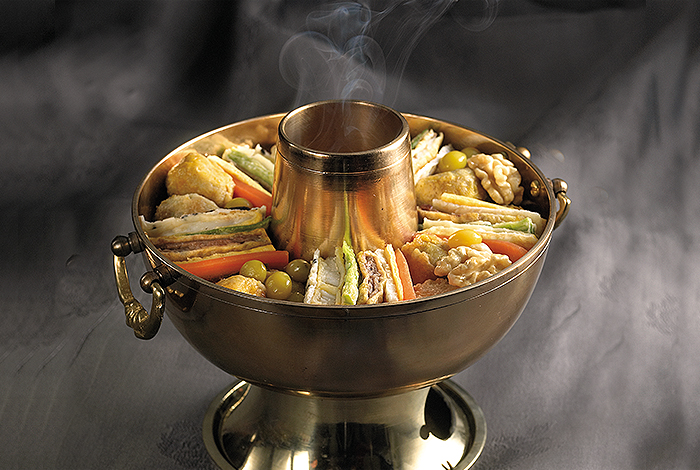
Joseon dynasty was the peak of royal culture in Korean history, and royal cuisine thus became the quintessence of traditional food culture in Korea. The meals served for the king were prepared by the best cooks in the court with quality ingredients procured from across the country, consisting of local specialties and fresh seasonal foods. Royal cuisine has been passed down by word of mouth of court cooks and royal descendants for generations, as well as in written records of royal feasts.
The Daily Meal Table in the Court
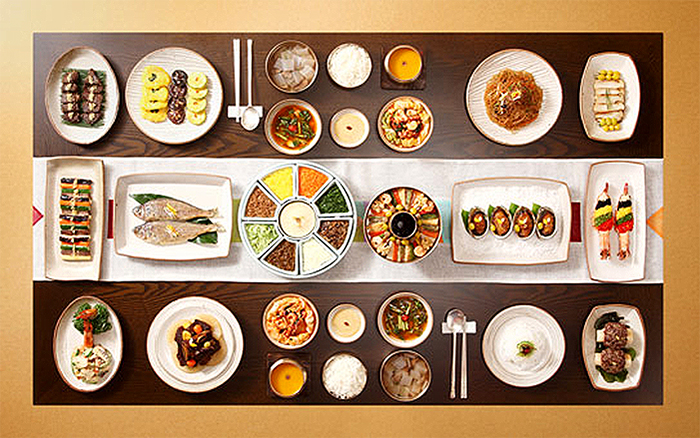
Records on the daily court meals of the Joseon dynasty can be found in “Wonhaeng Eulmyo Jeongni Uigwe” (Royal Protocols on a King’s Procession) which was written in 1795. The Royal Protocols provide a detailed description about the meals served during an eight-day journey of the king from Changdeokgung Palace to Suwon Hwaseong Fortress, where he hosted a feast before returning back to the palace.
Usually, meals were served five times a day: restorative medicine of rice gruel or porridge in the early morning; a royal breakfast table at around 10:00; a simple meal in the afternoon; a royal dinner table at around 17:00; and a simple meal at night.
The royal table called surasang, was served with 12 dishes, including rice and soup, as well as stew, hot pot, kimchi and sauces. Both white rice and sweet rice were served, and the most common soups were miyeok guk (seaweed soup) and gomtang (beef bone soup).
Surasang was further divided into daewonban (a large round table; the main table), gyeotban (a small round table), and chaeksangban (a square table).
The Dishes of Surasang
| Deoungui | grilled or brochette dish made with meat or fish |
|---|---|
| Changui | grilled or brochette dish made with dried seaweed, deodeok or vegetables |
| Jeonyuhwa | pan-fried delicacies made with meat, fish or vegetables |
| Pyeonyuk | boiled pork slices |
| Sukchae | boiled and seasoned vegetables |
| Saengchae | raw seasoned vegetables |
| Jorigae | braised dish made with meat, fish or vegetables |
| Janggwa | pickled vegetables |
| Jeotgal | salted seafood |
| Mareunchan | side dish made with dried, salted or fried beef, fish or kelp |
| Byeolchanhoe | raw or parboiled meat or fish cooked with vegetables |
| Byeolchansuran | suran (poached egg) or other special side dish |
| Chimchae | three kinds of kimchi (fermented vegetables) - songsongi (diced radish kimchi), cabbage kimchi, and dongchimi (radish water kimchi) |
| Jochi | two kinds of stew - tojangjochi (soybean paste stew) and jeotgukjochi (salted seafood stew) |
| Jjim | steamed dish made with meat, fish or vegetables |
| Sura & Tang | rice (white rice and red bean rice) & soup |
| Jeongol | meat and vegetables mixed in pot of soup and boiled to eat |
| Jangnyu | various sauces, such as soy sauce, soy sauce mixed with vinegar, red chili-pepper paste with vinegar, salted-shrimp juice, mustard, etc |
Surasang Table Setting
- Daewonban white rice, miyeok guk, togu (bone plate), soy sauce, soy sauce with vinegar, red chili paste with vinegar, changui, deoungui, raw fish, janggwa, saengchae, sukchae, suran, jeonyuhwa, jeotgal, jaban (salted fish), jorigae, pyeonyuk, songsongi, jeotgukji, dongchimi, jjim, tojangjochi, jeotgukjochi
- Sowonban red bean rice, gomtang, empty bowl, empty plate, tray, tea pot
- Chaeksangban sesame oil, meat, egg, vegetable, jangguk (clear soybean soup)
- Jeongolteul hot pot
Banquet Meals in the Court
In the royal court, a number of events were held throughout the year. Annual events occurred on national holidays such as Jeongwol (the day of the first full moon of the Lunar New Year), Dano (the 5th day of the 5th month in the lunar calendar), Chuseok (Korean Thanksgiving Day) and Dongji (winter solstice), as well as the birthdays of the royal family members residing in and outside of the court, the nomination and marriage of the crown prince, and welcoming events for foreign envoys. Jinyeon was a joyous feast in the royal court to celebrate a national event, while jinchan was held when there was a celebratory occasion within the royal family. In both cases, the banquet was planned and prepared for months leading up to the event day and the preparation process was kept on record.
During large royal banquets like jinyeon or jinchan, high-legged tables were set up. The tables were piled with tteok (rice cake) in a variety of colors and styles to make unique patterns, hangwa (traditional Korean snack) and fruits stacked in amazing towers. These stacks of food were generally 40-60 centimeters high, and held the meaning of wishing for prosperity and longevity of the king. The foods presented on the table were only for appearances and not actually eaten. Instead, the king would eat simple noodles and side dishes served at a smaller table before the large table was presented.
During birthdays of the royal family members or on holidays, guests were offered Myeonsang. Myeonsang was a table serving noodles, tteokguk (sliced rice cake soup) or mandu (dumplings) rather than rice. Side dishes of this table included pyeonyuk, hoe, jeonyuhwa and sinseollo (royal hot pot), as well as tteok and hangwa for dessert.
When a banquet was held, not only were royal guests offered food but other banquet participants as well, including the court musicians, dancers and soldiers, although tables were served by rank and position. After the banquet was finished, the remaining dishes were distributed to the king’s relatives and servants.
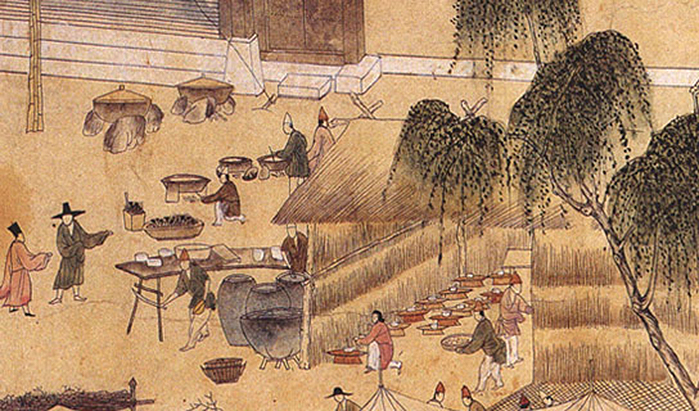 【 Seonmyojojejaegyeongsuyeondo – A painting recording a royal banquet, showing cooking preparations 】
【 Seonmyojojejaegyeongsuyeondo – A painting recording a royal banquet, showing cooking preparations 】 Inheritance of Royal Cuisine
Royal foods were prepared by court maids, who were given strict training about cooking from early childhood, as well as male cooks. Various kinds of royal cuisine were made with diverse cooking methods, as the foods were prepared using fresh seasonal ingredients and local specialties, including seafood, meat, vegetables and grains, to be served to the royal family. Vegetables and fish that looked irregular were not used. Instead, only ingredients that looked nice and the best parts of the ingredients were used to offer the best taste and style of the foods in hopes that the king would govern justly. Strong seasonings were not used in food preparation, and strong tastes, such as foods with salty and spicy flavors or with a strong smell, were avoided, so the meal could deliver the natural taste of the ingredients used.
The Joseon dynasty royal cuisine, which features such strict customs and manuals, was proclaimed an Important Intangible Cultural Property. Han Hui-sun (the first master of royal culinary art, 1889-1972) was a court maid who prepared meals for the last two kings of the Joseon dynasty (King Gojong: 1863-1907, King Sunjong: 1889-1971). Hwang Hae-sung succeeded to the title (the second master, 1920-2006) and promoted royal cuisine. Now, Han Bok-ryeo (the third master, 1947~) and Chung Gil-ja (the third master, 1948~) have followed in their footsteps.
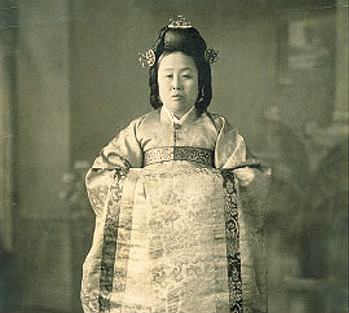 【 The 1st Master of Royal Culinary Art: Han Hui-sun 】
【 The 1st Master of Royal Culinary Art: Han Hui-sun 】 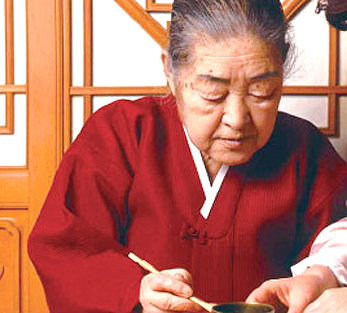 【 The 2nd Master: Hwang Hae-sung 】
【 The 2nd Master: Hwang Hae-sung 】 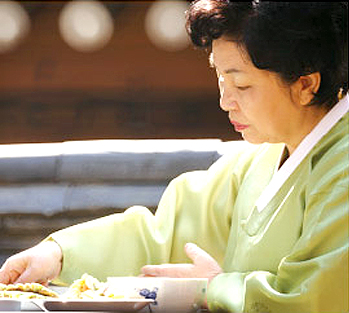 【 The 3rd Master: Han Bok-ryeo 】
【 The 3rd Master: Han Bok-ryeo 】 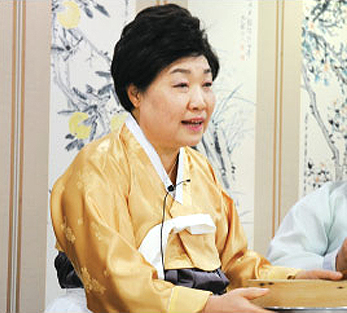 【 The 3rd Master: Chung Gil-ja 】
【 The 3rd Master: Chung Gil-ja 】
This page was last updated on October 6, 2021, and therefore information may differ from what is presented here.








